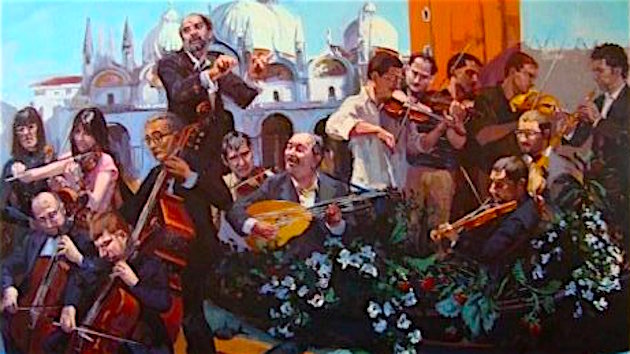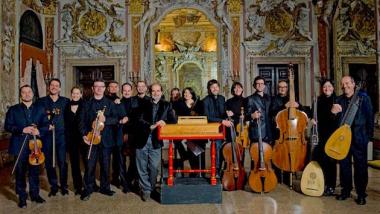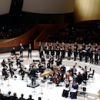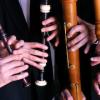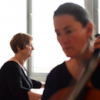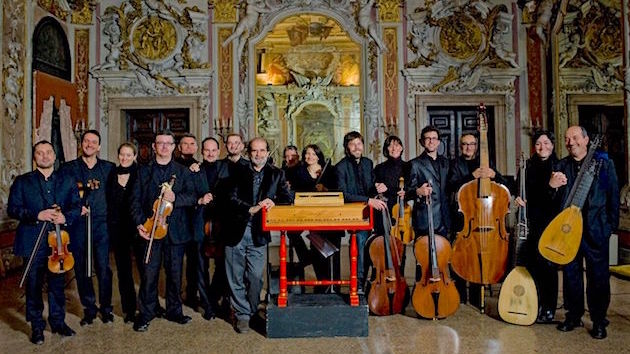
String instruments stand out from the rest of the orchestra because they can produce sustained notes or passages that are free from the limitations of breath or percussion. Drums fade as soon as they are struck, and wind players gasp for air, but string players persevere, their bows gliding back and forth across a fount of continuous sound. These stark divisions between percussion, winds, and strings are a given in the modern orchestra.
It was not always so. In its Oct. 27 performance at the Green Music Center, the 13-member Venice Baroque Orchestra aptly demonstrated that string instruments can be as percussive as drums. There were sustained notes, to be sure, but the dominant sound was of bows bouncing off strings like sticks off a snare drum. Spiccato and other bow-bouncing techniques were the order of the day, rather than the customary legato.
The bouncer-in-chief was concertmaster Gianpiero Zanocco, who was the soloist or co-soloist in three of the five Vivaldi concertos on the program. (The other offerings were two Vivaldi sinfonias and a concerto grosso by Francesco Geminiani.) Zanocco’s bow was a swirling dervish as it leaped from string to string, landing an impressive array of body blows in a vast range of bowing styles: spiccato, saltato, sautillé, collé, you name it. Most impressive was Zanocco’s flying spiccato, where he unleashed a blistering series of up-bows, followed by a resounding down-bow.
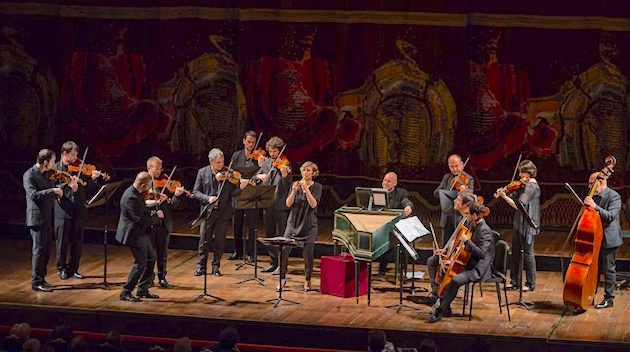
Zanocco heightened the percussive effect by eschewing vibrato, even in the slow movements. The result was an attenuated but pure sound, greatly enhanced in slow unison passages that he played with the seven other violins. The combination of percussion and purity, along with an accompanying harpsichord, ushered in a sonic universe utterly distinct from modern orchestral sound.
Cellist Massimo Raccanelli offered a different vision of Baroque style in his two concertos, one of which (RV 547) was for violin and cello. Although he played well with Zanocco in the double concerto, his real chance to shine came in the A-minor cello concerto (RV 419). Raccanelli’s solos were not as flashy as Zanocco’s, but they were more melodic and developed, with a greater sense of line and forward motion — almost like arias. And like a singer, Raccanelli luxuriated in occasional vibrato, especially in the slower passages. Many people stood to applaud his performance.
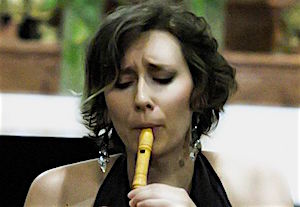
The full-bore standing ovation, however, came not for a string instrument but a recorder, masterfully played by Anna Fusek, who doubled as a violinist for the rest of the program. Like Raccanelli, she first teamed up with Zanocco for a double concerto (RV 535) and then got a star turn in her own concerto, the well-known “Il gardellino” (The goldfinch), RV 428. The latter concluded the program and brought down the house.
Fusek brings a big sound and lots of body movement to an exceptionally tiny instrument. When she came on stage for “Il gardellino,” she carried two recorders in her pocket. (She used the second for an encore.) She whipped out the first one and soon emitted a series of astonishing trills that sounded for all the world like a goldfinch warbling atop a branch. Her piercing tones soared above the orchestra and resonated throughout the hall. Meanwhile, she embodied the bird’s restless energy by leaning back and forth, sinking to her knees, and swaying in time. The full package — sound, movement, nature — was electrifying.
Fusek followed her bravura performance with a suitably Baroque encore: an abbreviated version of Gershwin’s “Rhapsody in Blue.” Honest. This enduring classic, forever riveted into our brains by United Airlines, sounds pretty good with a recorder substituting for the clarinet and a harpsichord for the piano. Many moments evoked laughter, and the players clearly had a good time jumping forward a few hundred years.
Another standing ovation followed, leading to a more predictable encore: the presto movement from the Summer concerto in Vivaldi’s The Four Seasons. The playing was spectacular, the dynamics perfect, and the sound distinctive — a furious drum roll of percussive strings.
